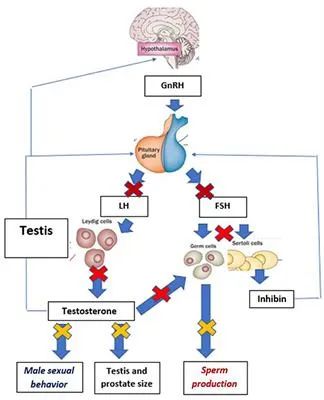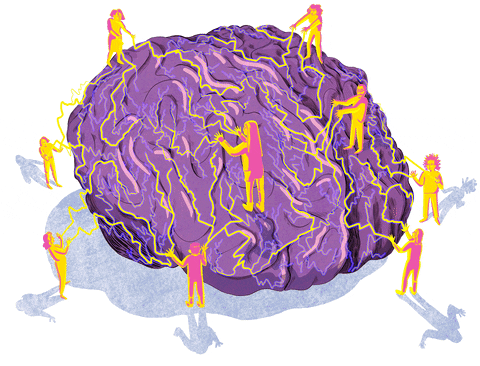New discovery!One hormone may improve the cognitive ability of Patients of Tang's syndrome
Author:Cool brain Time:2022.09.17


Via: freepi
The following is the audio of the full text of Miss Sister
Author | Simon Makin
Translation | Caroline
Grade -Cool Brain Creative
Reading | Hu En
Artist | Jenny
Edit | yj
A European research group shows that a known hormone-promote gonadotropin release hormone (GNRH) may represent a hopeful treatment for the cognitive issue of Tang's syndrome.
One of the 800 children suffers from Tang's syndrome at birth, which is the most common genetic cause of intellectual obstacles. Most cases are caused by three copies of chromosomes 21 instead of two copies.
The fertility of patients with Tang's syndrome will also decline, and their sense of smell is often damaged or lost. So far, it has not been found to treat the symptoms of this nervous system.

Via: pixabay
In a study published in the magazine of Science on September 1st, neurosenist Vincent Prevot (Vincent Prevot) and a European study of the neurostelist at the Instation Institute of France (French National Health and Medical Research Institute) and a European study The group shows that a known hormone-promote gonadotropin release hormone (GNRH) may represent a promising treatment of the cognitive problem of Tang's syndrome.
They found that among the Tang's syndrome model mice after genetic engineering design, the decline in GNRH levels is closely related to cognitive defects, and restoring GNRH may reverse this disability.
They also tested on seven men with Tang family syndrome, and six of them improved their cognitive ability. These results have paved the road for clinical trials, and may even have a wider range of applications in other cases involving the decline in cognitive ability, including Alzheimer's disease.

Via: Tuyuan Internet
For patients with Tang's syndrome, adolescence has brought about deterioration of cognitive symptoms, and many people have experienced a sense of smell. In a previous study, Predic and his colleagues discovered that before adolescence, a molecule "switch" was thrown out and improved the GNRH level. The switch involves molecules called Microsnas. These molecules exist in GnRH neurons. They control the release of GNRH to regulate adolescence.
These observations have prompted Predawrt and his colleagues to know if GNRH may play a dual role in Tang's syndrome, which affects fertility and maturity, and the degradation of cognitive ability.
GNRH neurons mainly exist in the hypothalamic brain. This is a deep brain area that controls body function, such as blood pressure and hunger. From there, they are connected to the pituitary gland, where the GNRH is released in pulse -like to regulate sexual development and fertility. All these are well understood, but some GnRH neurons are also connected to the cerebral cortex and hippocampus. These brain areas are related to learning and memory.
"People have always guessing that GNRH must do something in the brain," said the neurological biologist at Michigan State University. An attached comments. However, until now, researchers don't understand what it is.

Via: giphy
The research team studied three mice with three chromosomal copies 21 and showed the symptoms of Tang's syndrome. After seeing the olfactory and cognitive function and the decline in the level of GNRH, the researchers began to study whether these changes were reversible. They also observed that the MRNA and genetic networks that control the GNRH switch are unbalanced, so they first tried to increase the level of one of the mRNAs.
This eliminates a sense of smell and cognitive defects. "Spain's genomic regulatory center's neurobiologist Mara Dierssen said:" This work reveals a new role, such as MRNA, which may work in the neurology of Tang's syndrome.
In order to determine that this benefit is caused by GNRH, the research team uses several other technologies to improve hormones, including brain tissue transplantation of injection cells, health mice, and a technology called chemical genetic. A switch inserts neurons through genes and then activate with drugs.
The result is always the same: performance returns to the level of health mice. Similar results were also seen in mice who simulated Alzheimer's disease. "Predic said:" These results are so convincing that our clinical colleagues said, 'We must try this method on the Tang family syndrome patients'. "
The team subsequently conducted a pilot study among seven adult men with Tang family syndrome. The treatment involves the use of micro -pumping pulse injection GNRH with a micro -pump into the skin for six months. Participants accepted cognitive tests and brain imaging to evaluate the brain connection before and after treatment.
"Predic said:" Six of the seven patients increased by 20%to 30%in the cognitive test. "What is even more surprising is that we see that the functional connections of all seven people involving language and three -dimensional cortex are greatly improved. Specifically, speech understanding, temporary" work "memory and attention are all It has improved, but there is no sense of smell.

via: giphy
This treatment is also safe, which is not surprising, because it uses hormone pulses designed to imitate the natural release mode. "Huffman said:" What is exciting is that it has been with what exists. However, the ability to improve the cognitive ability of Tang's syndrome patients has not been scientifically proven.
"Stylianos Antonarakis, a geneticist at the University of Geneva, said:" The connection with human cognitive impairment is still hypothetical. Essence "Dirson said:" The research is a starting point for further research. Even if it is very promising, we should pay attention not to bring the expectations too high. "
Although the author saw defects in female mice, they did not test women in clinical research. Women's GNRH release mode is more complicated. "The change of pulse frequency is part of the menstrual cycle." Huffman said, "But I hope this can work in women."
A clinical trial of 70 men and women involved in multiple institutions will be launched in autumn. The team also plans to test this method under other conditions. "Predic said:" If GNRH therapy can improve the cognitive ability of this large group of Tang family syndrome, there are many possibilities. Mouse experiments show that it may slow down Alzheimer's cognitive ability.
In fact, there is already a clinical trial of molecularly treating Alzheimer's disease with GNRH. This technology may even help a decrease in cognitive ability related to age. "Huffman said," You will not postpone aging, but you may be able to delay the decline in cognitive ability, which is surprising enough. "

Via: giphy
Reference (click slide to view)
1. Messina, A., Langlet, F., Chachlaki, K., ROA, J., Rasika, Jouy, N., ... Prevot, V. (2016). Hypothalamic Gnrh Production Before Puberty. Nature Neuroscience, 19 (6), 835-844.
2. zhu, P. J., Khatiwada, S., CUI, Y., Reineke, L. C., DOOLING, S. W., Kim, J. J., ... Costa-Mattioli, M. (2019). Activity of the isrmediates the behavioral and neural state AbnoMalities in down syndrome. Science, 366 (6467), 843-849.


Cool brain long -term collection of brain science and psychological articles, welcome to submit
Please submit a mailbox: [email protected]
Click here, let friends know that you love brain science
- END -
Changchun Nanhu Middle Street (Weishan Road to Yimin Road) two -way opening to traffic

Finally, the two -way running through, the road to work this time is much more con...
Recommended reading | Little cute summer vacation into "home kitchen god"

In the early morning of July 12, Fang Lijuan, the class teacher of the first grade...